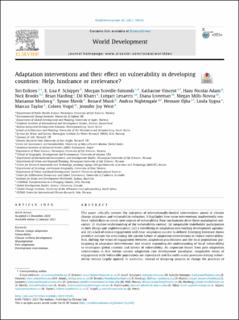| dc.contributor.author | Eriksen, Siri | |
| dc.contributor.author | Schipper, Emma Lisa | |
| dc.contributor.author | Scoville-Simonds, Morgan | |
| dc.contributor.author | Vincent, Katharine | |
| dc.contributor.author | Adam, Hans Nikolai | |
| dc.contributor.author | Harding, Brian | |
| dc.contributor.author | Khatri, Dil B. | |
| dc.contributor.author | Lenaerts, Lutgart | |
| dc.contributor.author | Liverman, Diana | |
| dc.contributor.author | Mosberg, Marianne | |
| dc.contributor.author | Movik, Synne | |
| dc.contributor.author | Muok, Benard | |
| dc.contributor.author | Nightingale, Andrea | |
| dc.contributor.author | Ojha, Hemant | |
| dc.contributor.author | Sygna, Linda | |
| dc.contributor.author | Taylor, Marcus | |
| dc.contributor.author | Vogel, Coleen | |
| dc.contributor.author | West, Jennifer Joy | |
| dc.date.accessioned | 2021-03-23T10:25:45Z | |
| dc.date.available | 2021-03-23T10:25:45Z | |
| dc.date.created | 2021-01-22T10:37:24Z | |
| dc.date.issued | 2021 | |
| dc.identifier.issn | 0305-750X | |
| dc.identifier.uri | https://hdl.handle.net/11250/2735022 | |
| dc.description.abstract | This paper critically reviews the outcomes of internationally-funded interventions aimed at climate change adaptation and vulnerability reduction. It highlights how some interventions inadvertently reinforce, redistribute or create new sources of vulnerability. Four mechanisms drive these maladaptive outcomes: (i) shallow understanding of the vulnerability context; (ii) inequitable stakeholder participation in both design and implementation; (iii) a retrofitting of adaptation into existing development agendas; and (iv) a lack of critical engagement with how ‘adaptation success’ is defined. Emerging literature shows potential avenues for overcoming the current failure of adaptation interventions to reduce vulnerability: first, shifting the terms of engagement between adaptation practitioners and the local populations participating in adaptation interventions; and second, expanding the understanding of ‘local’ vulnerability to encompass global contexts and drivers of vulnerability. An important lesson from past adaptation interventions is that within current adaptation cum development paradigms, inequitable terms of engagement with ‘vulnerable’ populations are reproduced and the multi-scalar processes driving vulnerability remain largely ignored. In particular, instead of designing projects to change the practices of marginalised populations, learning processes within organisations and with marginalised populations must be placed at the centre of adaptation objectives. We pose the question of whether scholarship and practice need to take a post-adaptation turn akin to post-development, by seeking a pluralism of ideas about adaptation while critically interrogating how these ideas form part of the politics of adaptation and potentially the processes (re)producing vulnerability. We caution that unless the politics of framing and of scale are explicitly tackled, transformational interventions risk having even more adverse effects on marginalised populations than current adaptation. | en_US |
| dc.language.iso | eng | en_US |
| dc.relation.uri | https://www.sciencedirect.com/science/article/pii/S0305750X20305118 | |
| dc.rights | Attribution-NonCommercial-NoDerivatives 4.0 Internasjonal | * |
| dc.rights.uri | http://creativecommons.org/licenses/by-nc-nd/4.0/deed.no | * |
| dc.title | Adaptation interventions and their effect on vulnerability in developing countries: Help, hindrance or irrelevance? | en_US |
| dc.type | Peer reviewed | en_US |
| dc.type | Journal article | en_US |
| dc.description.version | publishedVersion | en_US |
| dc.source.volume | 141 | en_US |
| dc.source.journal | World Development | en_US |
| dc.identifier.doi | 10.1016/j.worlddev.2020.105383 | |
| dc.identifier.cristin | 1876988 | |
| dc.source.articlenumber | 105383 | en_US |
| cristin.ispublished | true | |
| cristin.fulltext | original | |
| cristin.qualitycode | 2 | |

